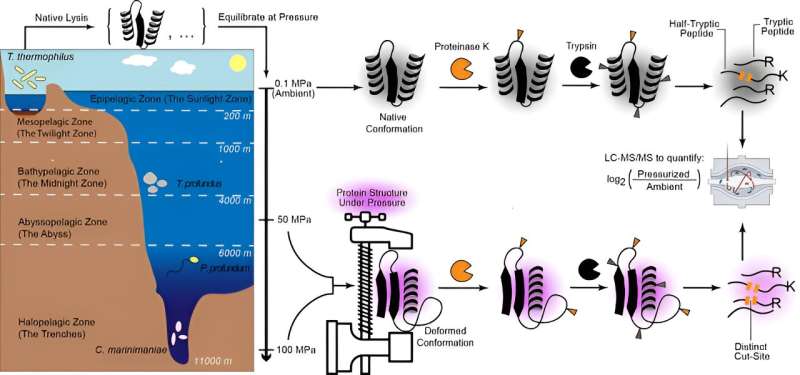This article has been reviewed according to Science X's editorial process and policies. Editors have highlighted the following attributes while ensuring the content's credibility:
fact-checked
peer-reviewed publication
trusted source
proofread
With AI, extreme microbe reveals how life's building blocks adapt to high pressure

An assist from a Google Artificial Intelligence tool has helped scientists discover how the proteins of a heat-loving microbe respond to the crushing conditions of the planet's deepest ocean trenches, offering new insights into how these building blocks of life might have evolved under early Earth conditions.
The findings, published in PRX Life, will likely prompt further studies into the inner workings of proteins and life on other planets, and serve as a successful case study on how artificial intelligence was able to accelerate such research by decades.
"This work gives us a better idea of how you might design a new protein to withstand stress and new clues into what types of proteins would be more likely to exist in high-pressure environments like those at the bottom of the ocean or on a different planet," said Stephen Fried, a Johns Hopkins University chemist who co-led the research.
Fried's team subjected Thermus thermophilus—a microorganism widely used in scientific experiments owing to its ability to withstand heat—to lab-simulated pressures mimicking those of the Mariana Trench. The tests revealed some of its proteins resist those stress levels because they have a built-in flexibility with extra space between their atomic structures, a design that allows them to compress without collapsing.
The way a protein's building blocks, or amino acid chains, "fold" or organize into 3D structures determines their function. But these structures can be very sensitive to temperature, pressure, and other factors in the environment (as well as biochemical and genetic mishaps) that cause them to misfold into dysfunctional shapes.
The analysis shows 60% of the proteins in the bacteria resisted the pressure while the rest buckled under it and their shapes became deformed, specifically at points or sites known to be of important biochemical function. The insights could help explain how other organisms thrive under extreme pressures that would kill most living things.
"Life has obviously had an evolutionary drive to adapt to different environments over billions of years, but evolution can sometimes almost sound like a magical thing," Fried said. "Here, we really get down to the biophysics of how that happens and see it's because of a simple geometrical solution in the 3D arrangement of these proteins' building blocks."
The findings are a testament to the potential of artificial intelligence for scientific discovery, Fried said. By integrating the power of Google's AlphaFold tool, the team mapped the pressure-sensitive parts of T. thermophilus' entire set of proteins. The AI tool predicted the structure of the organism's more than 2,500 proteins, helping the team calculate the correlation between their configurations and their ability to resist pressure changes—a feat that would have taken many decades to complete with direct measurements alone, Fried said.
Although the model organism is known for its ability to thrive around hot springs or hydrothermal vents instead of its ability to withstand deep ocean pressures, the findings could shed light on deep ocean life that is supremely understudied—as well as unknown—said author Haley Moran, a Johns Hopkins chemist who studies "extreme" organisms.
"A lot of people predict if we are going to find extraterrestrial life, we're going to find it deep in the ocean of some planet or moon. But we don't fully understand life in our own ocean, where there are many different species that don't just tolerate what would kill us, they love it and thrive in it," Moran said. "We are taking proteins, one of the building blocks of life, and putting them under these extreme conditions to see how they may adapt to push the bounds of life."
The findings also highlight how high-pressure tests could reveal additional molecular functions that remain hidden in other organisms. Until now, conventional thinking has been that pressure levels would need to be cranked up far beyond the ocean trench level to influence a protein's biochemistry, said author Richard Gillilan, a Cornell University chemist who helped devise the high-pressure experiments.
"We were really caught by surprise, but as we continued to double-check the numbers and examine individual molecular structures, we realized this was a treasure map," Gillilan said. "We have opened a door that will provide many new targets for structural and biophysical studies, perhaps even drug discovery."
The team will next move on to conduct experiments on other organisms, specifically those that thrive under high pressures in the deep ocean.
Other authors are Edgar Manriquez-Sandoval and Piyoosh Sharma of Johns Hopkins.
More information: Haley M. Moran et al, Proteome-Wide Assessment of Protein Structural Perturbations under High Pressure, PRX Life (2024). DOI: 10.1103/PRXLife.2.033011
Journal information: PRX Life
Provided by Johns Hopkins University




















